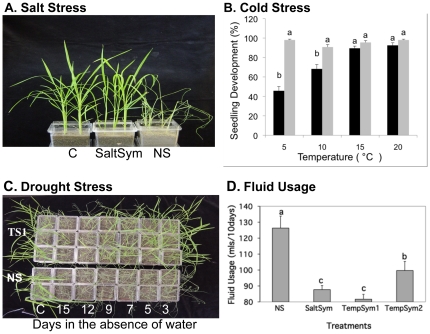Figure 3. Effects of salt, cold and drought stress and water usage in S and NS rice plants under laboratory conditions.
The number of plants or seedlings/treatment are indicated by (N = XX), and the % survival and health of surviving plants is indicated in parentheses after each treatment (Fig. 3A &C). Plant health was based on comparison to NS controls and rated from 1 to 5 (1 = dead, 2 = severely wilted and chlorotic, 3 = wilted +/− chlorosis, 4 = slightly wilted, 5 = healthy w/o lesions or wilting). All assays described from left to right and images are representative of all plants/treatment. A) Rice plants (N = 60), no stress controls (labeled "C") representative of both S and NS plants (100%, 5), S with SaltSym (100%, 5), or NS (0%, 1) exposed to 300 mM NaCl for 21 days. While all plants bent over with age, unstressed controls and salt exposed S plants remained hydrated while the NS plants wilted. B) The % rice seedling development at 5–20°C of NS (black bars) and TempSym1 colonized (grey bars) treatments were assessed. After the initial sterilization and imbibing process (see Materials and Methods), seeds (N = 20) were placed on agar water media plates, and +/− inoculated with the fungal symbiont, and % seedling development assessed after ten days. Statistical analysis (Duncan's multiple-range test; SE≤4.48; P≤0.001) indicated the % seedling development was significantly higher at 5°C and 10°C in S treatments but not at 15°C and 20°C. C) Representative photo of five week old rice plants (N = 140–210) that are NS or S with TempSym1 (TS1). From Left to right: control plants (C) were kept hydrated and healthy (100%, 5) for both treatments. The remaining plants were not watered for 15,12, 9,7, 5, and 3 days. Post drought stress, plants were re-hydrated for 2 days and viability assessed. After 3 days, NS plants began to show the effects of drought (70%, 2; 25%, 1) and after>5 days, NS plants succumbed to the stress (>90%, 1). In contrast, S plants did not show the effects of drought until after 12 days (70%, 1; 30%, 2). Moreover, S plants remained green and robust in the absence of water for 9 days (≥90%, 5) as visualized by a general thicker, green canopy. D) Fluid usage of 5 week old NS or S (SaltSym, TempSym1, and TempSym2) rice plants (N = 60) as ml of fluid used over a ten day period. Statistical analysis (Duncan's multiple-range test) indicated significant differences in fluid usage (SD≤7.51; P<0.05) with all three symbionts using less fluid compared to NS plants.

